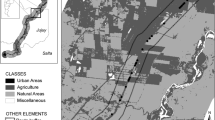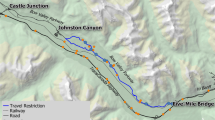Abstract
Road-based distance sampling is a common technique used to estimate the density of many wildlife species but potential biases exist unless the target population is randomly distributed around roads. Our objective was to determine if and when Rio Grande wild turkeys (Meleagris gallopavo intermedia; RGWT) were randomly distributed around roads to identify time periods in which road-based surveys would be most appropriate. We used triangulated locations obtained from radiotelemetry of RGWTs in the Edwards Plateau (2001–2003), Rolling Plains (2000–2006), and South Texas (2003–2006) ecoregions. Using a geographic information system, we conducted a use and availability analysis by sex, season, and time of day for each ecoregion to determine RGWT use of areas near roads (<200 m). We found the most appropriate time to conduct road-based distance sampling was from 1 December to 15 March during morning or afternoon. Our results suggested road-based surveys conducted during these periods should yield generally unbiased results in the Rolling Plains and Edwards Plateau ecoregions. We recommend researchers and managers investigate animal distributions around roads before implementing road-based monitoring programs for other wildlife species.

Similar content being viewed by others
References
Anderson DR (2001) The need to get the basics right in wildlife field studies. Wildl Soc Bull 29:1294–1297
Bailey W, Dennett D Jr, Gore H, Pack J, Simpson R, Wright G (1980) Basic considerations and general recommendations for trapping wild turkey. Proc Natl Wild Turkey Symp 4:10–23
Beyer HL (2004) Hawth’s Analysis Tools for ArcGIS. http://www.spatialecology.com/htools. Accessed 5 Oct 2007
Bibby CJ, Burgess ND, Hill DA, Mustoe SH (2000) Bird census techniques, 2nd edn. Academic, San Diego, CA
Borralho R, Rego F, Vaz Pinto P (1996) Is driven transect sampling suitable for estimating red-legged partridge Alectoris rufa densities? Wildl Bio 2:259–268
Brennan LA, Block WM (1986) Line transect estimates of mountain quail density. J Wildl Manage 50:373–377
Buckland ST, Anderson DR, Burnham KP, Laake JL, Borchers DL, Thomas L (2001) Introduction to distance sampling: estimating abundance of biological populations. Oxford University Press, New York, NY
Burnham KP, Anderson DR, Laake JL (1980) Estimation of density from line transect sampling of biological populations. Wildl Monogr 72:13–36
Butler MJ, Ballard WB, Wallace MC, DeMaso SJ (2007) Road-based surveys for estimating wild turkey density in the Texas Rolling Plains. J Wildl Manage 71:1646–1653
Butler MJ, Teaschner AP, Ballard WB, McGee BK (2005a) Commentary: wildlife ranching in North America—arguments, issues, and perspectives. Wildl Soc Bull 33:381–389
Butler MJ, Wallace MC, Ballard WB, DeMaso SJ, Applegate RD (2005b) From the field: the relationship of Rio Grande wild turkey distributions to roads. Wildl Soc Bull 33:745–748
Collier BA, Jones DA, Schaap JN, Randel CJ III, Willsey BJ, Aguirre R, Schwertner TW, Silvy NJ, Peterson MJ (2007a) Survival of Rio Grande wild turkeys on the Edwards Plateau of Texas. J Wildl Manage 71:82–86
Collier BA, Melton KB, Dreibelbis JZ, Kuvlesky WP, Proudfoot GA, Aguirre R, Hewitt D, Schwertner TW, DeMaso SJ, Peterson NJ (2007b) Variation in brood sex ratios of Texas Rio Grande wild turkeys. J Wildl Manage 71:1793–1799
Conover WJ (1999) Practical nonparametric statistics, 3rd edn. John Wiley and Sons, Inc., New York, NY
Davis BD (1994) A funnel trap for Rio Grande turkey. Proc Annu Conf Southeast Assoc Fish Wildl Agencies 48:109–116
DeYoung CA, Priebe JC (1987) Comparison of inventory methods for wild turkeys in South Texas. Proc Annu Conf Southeast Assoc Fish Wildl Agencies 41:294–298
Erxleben DR (2008) Evaluation of road-based surveys of Rio Grande wild turkeys in Texas. Texas Tech University, Lubbock, Thesis
Erxleben DR, Butler MJ, Ballard WB, Wallace MC, Hardin JB, DeMaso SJ (2010) Encounter rates from road-based surveys of Rio Grande wild turkeys in Texas. J Wildl Manage 74 (in press)
Glazener WC, Jackson AS, Cox ML (1964) The Texas drop-net turkey trap. J Wildl Manage 28:280–287
Griffith GE, Bryce SA, Omernik JM, Comstock JA, Rogers AC, Harrison B, Hatch SL, Bezanson D (2004) Ecoregions of Texas (color poster with map, descriptive text, and photographs). US Geological Survey, Reston, VA
Gould FW (1962) Texas plants, a checklist and ecological summary. Publication MP-585, Texas Agricultural Experiment Station, The Agricultural and Mechanical College of Texas
Haines AM, Hernandez F, Henke SE, Bingham RL (2004) Effects of road baiting on home range and survival of northern bobwhites in southern Texas. Wildl Soc Bull 32:401–411
Hall GI (2005) Relationships between cattle grazing and Rio Grande wild turkeys in the Southern Great Plains. Texas Tech University, Thesis
Hall GI, Wallace MC, Ballard WB, Ruthven DC III, Butler MJ, Houchin RL, Huffman RT, Phillips RS, Applegate RD (2007) Rio Grande wild turkey habitat selection in the Southern Great Plains. J Wildl Manage 71:2583–2591
Hernandez F, Arredondo JA, Bryant FC, Brennan LA, Bingham RL (2005) Influence of precipitation on demographics of northern bobwhites in southern Texas. Wildl Soc Bull 3:1071–1079
Holdstock DP, Wallace MC, Ballard WB, Brunjes JH, Phillips RS, Spears BL, DeMaso SJ, Jernigan JD, Applegate RD, Gipson PS (2006) Male Rio Grande turkey survival and movements in the Texas Panhandle and southwestern Kansas. J Wildl Manage 70:904–913
Huffman RT, Wallace MC, Ballard WB, Hall G, Houchin R, Applegate R, DeMaso SJ, Gipson PS (2006) Nesting habitat of Rio Grande wild turkeys. In: Cain JW III, Krausman PR (eds) Managing wildlife in the southwest: new challenges for the 21st century. The Southwest Section of The Wildlife Society, 9–11 August 2005, Alpine, TX, pp 103–111
Marques TA (2007) Incorporating measurement error and density gradients in distance sampling surveys. Ph.D. Thesis, University of St Andrews, Scotland, United Kingdom
Melton KB (2007) Reproductive ecology of Rio Grande wild turkey in the Edwards Plateau of Texas. Thesis, Texas A&M University
McDougal LA, Vaughan MR, Bromley PT (1990) Wild turkey and road relationships on a Virginia national forest. Proc Natl Wild Turkey Symp 6:96–106
Millsap BA, LeFranc MN Jr (1988) Road transect counts for raptors: how reliable are they? J Raptor Research 22:8–16
Peterson MN, Aguirre R, Lawyer TA, Jones DA, Schaap JN, Peterson MJ, Silvy NJ (2003) Animal welfare-based modification of the Rio Grande wild turkey funnel trap. Proc Annu Conf Southeast Assoc of Fish Wildl Agencies 57:208–212
Randel CJ III (2003) Influences of vegetation characteristics and invertebrate abundance on Rio Grande wild turkey populations, Edwards Plateau, Texas. Thesis, Texas A&M University, College Station
Rogers TD, Wakeling BF, Boe SR (1999) Merriam’s turkey distribution in Relation to the US Forest Service recreational opportunity spectrum forest classification and road proximity in north-central Arizona. Proc Bien Conf Research Colorado Plateau 4:133–142
Spears BL (2002) Wild turkey pre-flight poult habitat characteristics and survival. Texas Tech University, Lubbock, Thesis
Spears BL, Ballard WB, Wallace MC, Phillips RS, Holdstock DP, Brunjes JH, Applegate R, Gipson PS, Miller MS, Barnett T (2002) Retention times of miniature radiotransmitters glued to wild turkey poults. Wildl Soc Bull 30:861–867
Spears BL, Wallace MC, Ballard WB, Phillips RS, Holdstock DP, Brunjes JH, Applegate R, Miller MS, Gipson PS (2007) Habitat use and survival of preflight wild turkey broods. J Wildl Manage 71:69–81
Texas Economic Development and Tourism (2003) Texas elevation ranges. http://www.bidc.state.tx.us/BIDC_Maps/TX_Maps/ENV/ElevationRanges.pdf. Accessed 14 May 2007
Thompson WL, White GC, Gowan C (1998) Monitoring vertebrate populations. Academic, San Diego, CA
Verner J (1985) Assessment of counting techniques. Current Ornithol 2:247–302
Wegge P, Finne MH, Rolstad J (2007) GPS satellite telemetry provides new insight into Capercaillie Tetrao urogallus brood movements. Wildlife Biology 13:87–94
Wright GA, Speake DW (1975) Compatibility of the eastern wild turkey with recreational activities at Land Between the Lakes, Kentucky. Proc Annu Conf Southeast Assoc Fish Wildl Agencies 29:578–584
Acknowledgments
This study was funded by Texas Parks and Wildlife Department, Texas Tech University, The National Wild Turkey Federation, and The Texas Chapter of the National Wild Turkey Federation. We thank researchers from Texas A&M University, Texas A&M University–Kingsville, and Texas Tech University for allowing use of their data for these analyses. We also thank the Caesar Kleberg Foundation for Wildlife Conservation. We thank the Gene Howe WMA; the Matador WMA; private ranches in Donley, Collingsworth, Bandera, Real, and Kerr counties; and King Ranch, Inc. for allowing research on their properties. We also thank R. Howard of the San Tomas Hunting Camp and Freeport-McMoRan, Inc., and B. Richardson of the Mota Bonita Hunting Camp and Halliburton, Inc. for providing meals and logistical support in South Texas. Many thanks to R. Phillips, S. McKenzie, R. Swearingin, R. Walker, B. Petersen, J. Brunjes IV, G. Hall, R. Houchin, R. Huffman, T. Barnett, D. Holdstock, B. Spears, J. Bullock, A. Ortega-Santos, C. Lawson, S. Burns, R. Guaernos-Altamirano, E. Reyes, J. Martinez, R. Schrum, J. Montalvo, S. Vasquez, D. Jones, C. Randel III, J. Schaap, and B. Willsey for collecting radiotelemetry data. We also thank B. Collier, M. Conner, and 2 anonymous reviewers for their valuable comments and suggestions on this manuscript. This is Texas Tech University, College of Agricultural Science and Natural Resources technical publication T-9-1172. This research complies with current Texas and US laws.
Author information
Authors and Affiliations
Corresponding author
Additional information
Communicated by H. Kierdorf
Rights and permissions
About this article
Cite this article
Erxleben, D.R., Butler, M.J., Ballard, W.B. et al. Wild Turkey (Meleagris gallopavo) association to roads: implications for distance sampling. Eur J Wildl Res 57, 57–65 (2011). https://doi.org/10.1007/s10344-010-0399-4
Received:
Revised:
Accepted:
Published:
Issue Date:
DOI: https://doi.org/10.1007/s10344-010-0399-4




